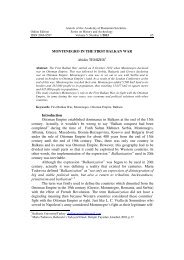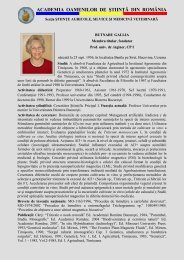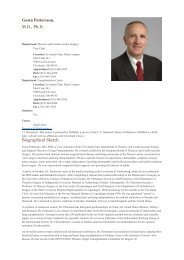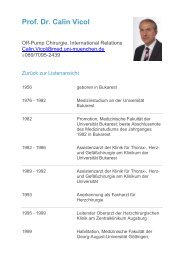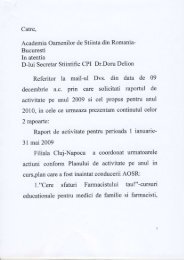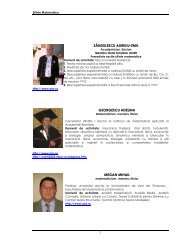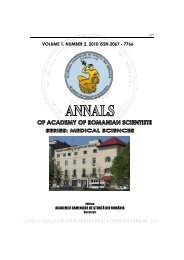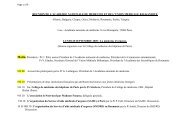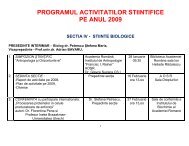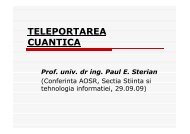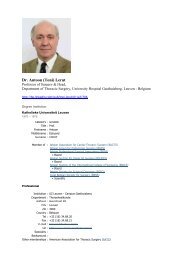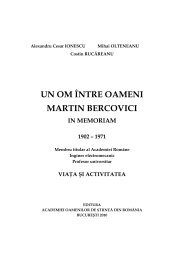Volume 3 nr 1 / 2011 - Academia Oamenilor de Stiinta din Romania
Volume 3 nr 1 / 2011 - Academia Oamenilor de Stiinta din Romania
Volume 3 nr 1 / 2011 - Academia Oamenilor de Stiinta din Romania
- No tags were found...
You also want an ePaper? Increase the reach of your titles
YUMPU automatically turns print PDFs into web optimized ePapers that Google loves.
The Study of Heavy Metal from Environmental Samples by Atomic Techniques 392.2. Methods2.2.1. Energy Dispersive X-ray FluorescenceTwo grams of sample (n = 6) for each species collected and soil collected from forestarea, Dambovița County, <strong>Romania</strong> were pressed manually, without any chemicaltreatment, in a plastic vial with Mylar in the bottom and then were analyzed.The elemental content of samples was <strong>de</strong>termined by Energy Dispersive X-RayFluorescence (EDXRF) [12-14] technique, using the ElvaX spectrometer having aX-ray tube with Rh ano<strong>de</strong>, operated at 50 kV and 100µA. Samples were excitedfor 300 s and the characteristic X-rays were <strong>de</strong>tected by a multichannelspectrometer based on a solid state Si-pin-dio<strong>de</strong> X-ray <strong>de</strong>tector with a 140 µm Bewindow and a energy resolution of 200eV at 5.9 KeV. ElvaX software was usedto interpret the EDXRF spectra. The accuracy and precision of the results wasevaluated by measuring a certified reference sample (NIST SRM 1571- Orchardleaves). Good agreements were achieved between certified values and dataobtained, with recoveries ranging from 98 to 104%.2.2.2. Atomic Absorption SpectrometryThe Atomic Absorption Spectrometry (AAS)[16], is the most wi<strong>de</strong>ly utilizedmethod today for rapid and quantitative elemental analysis. The <strong>de</strong>tection limit inAAS analysis method is up to 0.1 µg/kg un<strong>de</strong>r optimum test conditions. Amaterial sample, in a liquid solution, is atomized through rapid heat applicationand placed in the radiation path of several element-specific light source.Thesample atoms absorb ultraviolet or visible light and make transitions to higherelectronic energy levels. The analyte concentration is <strong>de</strong>termined from the amountof light absorption. The atomic <strong>de</strong>nsity <strong>de</strong>termine the absorption rate and theLambert-Beer’s law give the value of absorbance from each element of the samplewhich is proportional with the concentration of that element. The Lambert-Beerlaw is difficult to applying directly in AAS due to variations in the atomizationefficiency from the sample matrix, and nonuniformity of concentration and pathlength of analyte atoms (in graphite furnace AA).The high sensitivity by AAS isobtained using the relative analysis method.Mushroom is a very specific sample for <strong>de</strong>struction. It contains plant oils andchitin in the cell membrane which is difficult to <strong>de</strong>stroy. In this study driedsamples was digested in an acid solution using a Berghof MWS-2 microwavedigestion system. The Teflon digestion vessels used in this procedure wasreusable and the clean-up step was relatively easy and less time consuming. Driedfungus samples (500 mg) were introduced into the digestion vessels; then 3 mLnitric acid and 5 mL hydrogen peroxi<strong>de</strong> were ad<strong>de</strong>d. After digestion time (40 min)the vessels were cooled to room temperature (about 30 min.). The clear solutionCopyright © Editura Aca<strong>de</strong>miei <strong>Oamenilor</strong> <strong>de</strong> Știință <strong>din</strong> România, <strong>2011</strong>Watermark Protected



